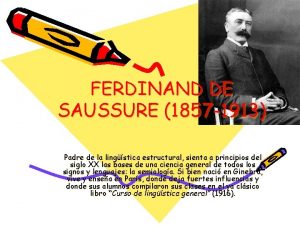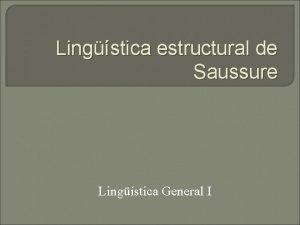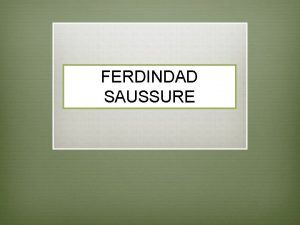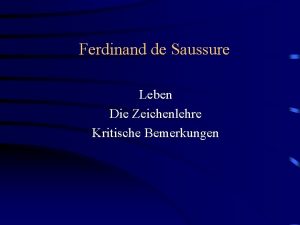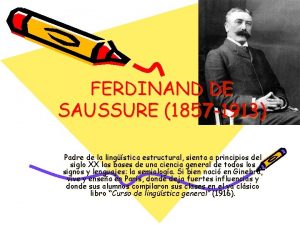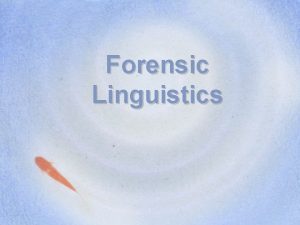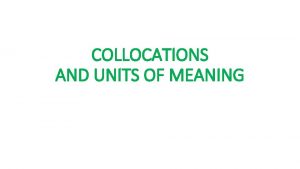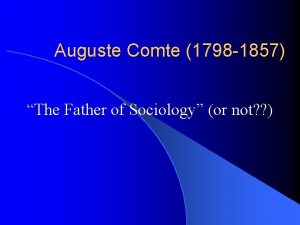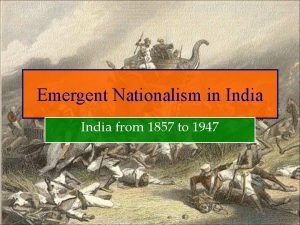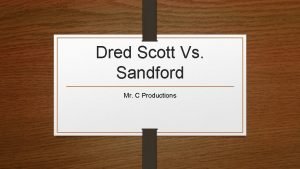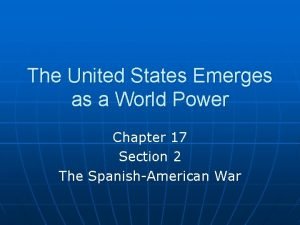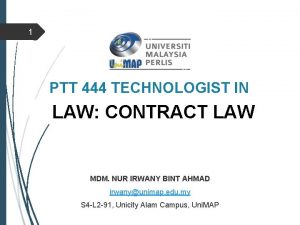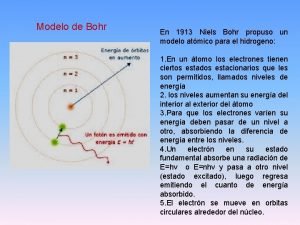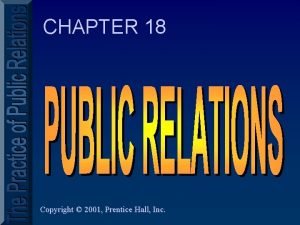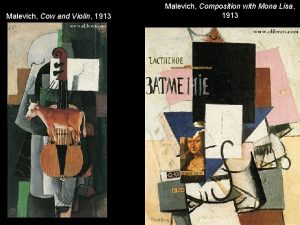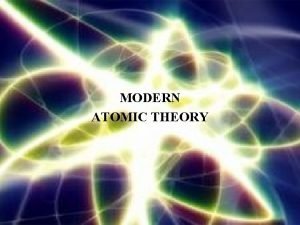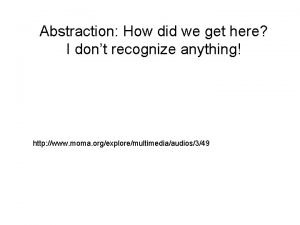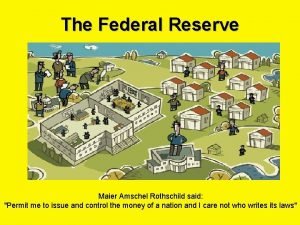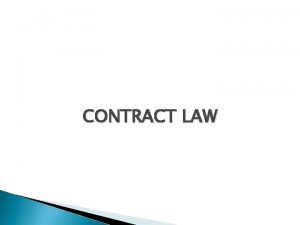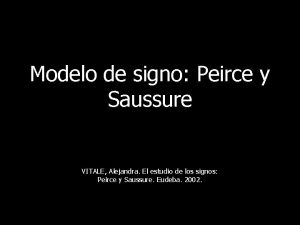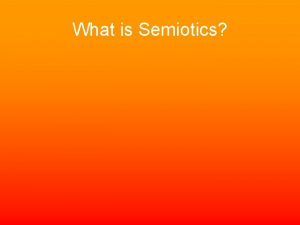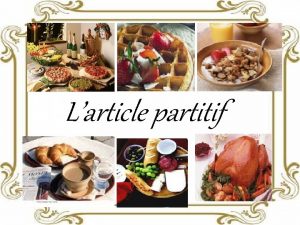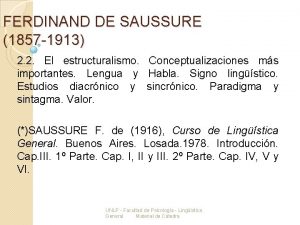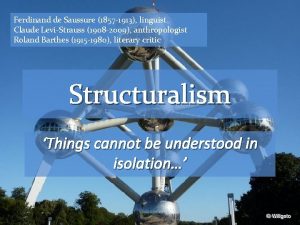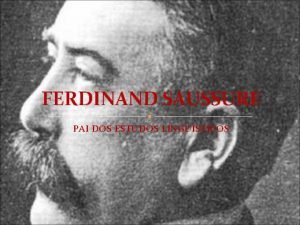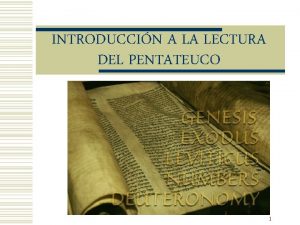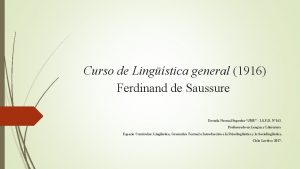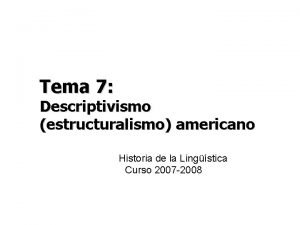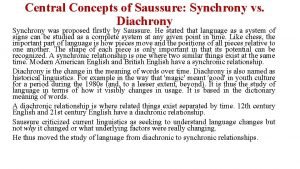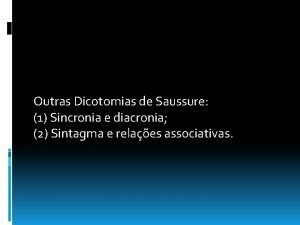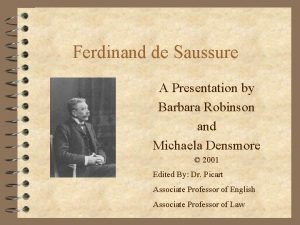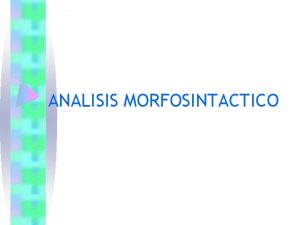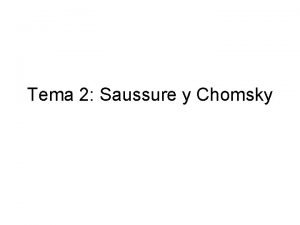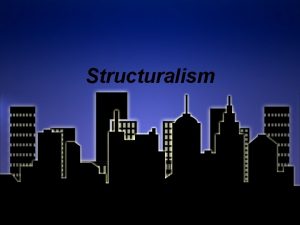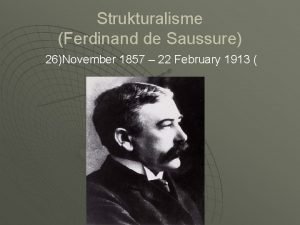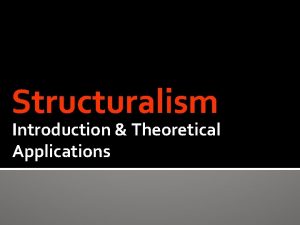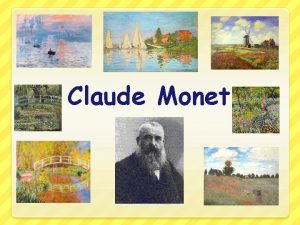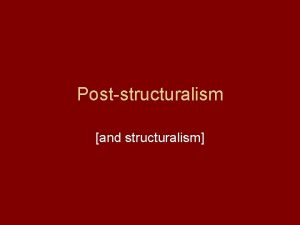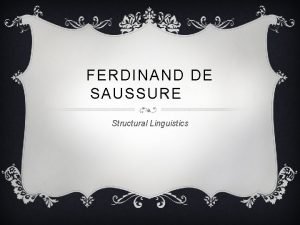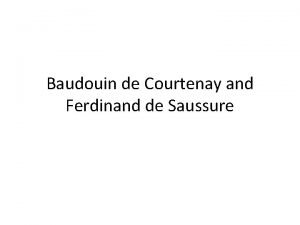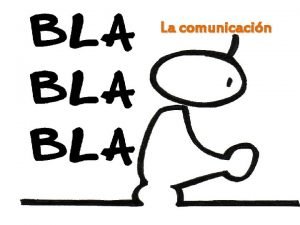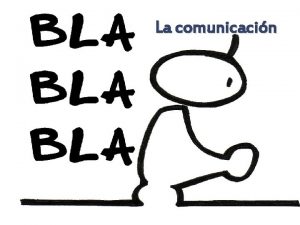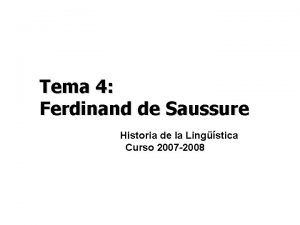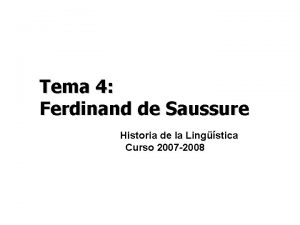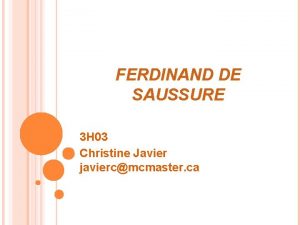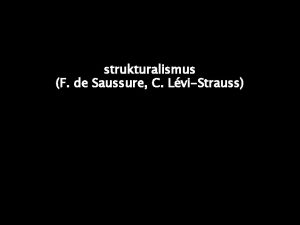Ferdinand de Saussure 1857 1913 linguist Claude LeviStrauss


















































- Slides: 50

Ferdinand de Saussure (1857 -1913), linguist Claude Levi-Strauss (1908 -2009), anthropologist Roland Barthes (1915 -1980), literary critic Structuralism ‘Things cannot be understood in isolation…’

Structuralism • Take a well-known media text. Let’s say, The Dark Knight (2011). • A structuralist would argue that The Dark Knight cannot be fully understood without knowledge of the history of the many Batman movies, and in turn, the comic book in which the character originated.

Structuralism • Take a well-known media text. Let’s say, The Dark Knight (2011). • In turn, comic book heroes can’t be understood in isolation – we must recognise Batman as one of many superheroes in the Marvel and DC Universe.

Structuralism • Take a well-known media text. Let’s say, The Dark Knight (2011). • Furthermore, we must understand comic books as having certain characteristics different from other literature, such as children’s books, graphic novels or video games.

Structuralism Children’s literature Comic Books DC Comics Batman & Robin (1960 s TV show) Marvel Christopher Nolan’s Batman series Batman Forever The Dark Knight Graphic Novels Batman Begins Animated Batman (1990 s TV series) New Batman & Robin (1990 s revival) Video Games

Structuralism • These are all just some of the cultural structures that seem to take us further and further away from our original text – The Dark Knight (2011).

Structuralism • So, structuralists say that the meaning of a text is not contained within it, but in the cultural relationships surrounding and connecting it. • The focus is not on the text itself, but on the larger, abstract structures than contain them.

Structuralism Structuralists consider: – – – Genre Over-arching narrative Source text Style influences Stock characters Binary opposites Recurring themes Text’s position in the series of sequels/prequels/spin-offs Adaptations Text’s position within director’s previous work Text’s position within actor’s previous work

Structuralism Task • Choose a media text. • Draw its network of cultural structures, like I have done for The Dark Knight.

Saussure The structure of language and the relationships of meaning

Ferdinand de Saussure (1857 -1913) • Swiss linguist and semiotician • His ideas laid the foundation for many significant developments in linguistics and semiotics. • He wasn’t described as a structuralist, but the structuralists of the 1950 s would consider him the father of their theories.

• What does the word ‘hut’ mean to you? • Is there any reason why those particular three letters – ‘h’, ‘u’ and ‘t’ – and the sound they produce, make us think of an image of a small dwelling? • No, it is an arbitrary association.

• The word ‘hut’, for instance, is not in any way appropriate to its meaning. • The meaning of the word ‘hut’ is maintained by convention only.

• So, Saussure said that the meaning attached to all words are arbitrary; they are there only by convention. • Discuss: Can you think of a type of word that might be an exception?

• He said that the minor exception to this is the small group of words called onomatopoeia – words created out of the sound that something makes. • However, not even these are fixed, because they vary between languages…

Onomatopoeia

Onomatopoeia

Onomatopoeia

• So, if a word’s association to its meaning is just random, then language isn’t a reflection of the world, but a completely different system altogether.

• Saussure also emphasised that the meanings of words are relational. That is to say, no word can be defined in isolation from other words. • For example, the word ‘hut’ depends on its position in a chain of other words for it to be understood.

Task • Fill in the gaps in the chain: Shed Hut House Mansion Palace

• So, we define a word such as ‘mansion’ by explaining its position between the two words either side of it. Shed Hut House Mansion Palace


c One man’s terrorist is another man’s freedom fighter • What is meant by this statement? • Can you think of any similar statements?

• So, finally, Saussure stated that meaning does not exist within the word itself. • Meaning is applied by experiencing an object/concept and labelling it with a word based on your own previous experiences.

• Another example is colour. The words for colours ‘make’ a reality. The spectrum isn’t divided into 7 colours. They all merge into one another. We just label useful points on that spectrum.


In summary: 0 • Meanings attached to words are only arbitrary • The meaning of words can only be understood in relation to other words • Meaning does not exist within the word itself – we apply our own labels to experiences

Structuralists found Saussure’s distinctions useful because they showed that the meaning of a text doesn’t exist within itself. It must be understood in relation to the structures surrounding and connecting it.

Task Can you find any flaws in Saussure’s argument?

Claude Levi. Strauss Structuralism and Binary Opposition

Claude Levi-Strauss Task • Connect the binary opposites to each other. . .

Claude Levi-Strauss • Levi-Strauss was a French anthropologist - now considered one of the ‘fathers of anthropology’who in the 1950 s developed some of Saussure’s theories into what is called Structuralism.

Claude Levi-Strauss • Levi-Strauss studied hundreds of myths and legends around the world, as well as modern texts such as Hollywood Westerns.

Claude Levi-Strauss • He said that as humans, we make sense of the world, people and events by seeing and using. . . binary opposites.

Claude Levi-Strauss • This structuralist idea is also an important narrative theory, because he said: “all narratives are arranged around the conflict of binary opposites. ”

Claude Levi-Strauss • Just like Saussure, who said words can only be understood in relation to the words around so Levi-Strauss said them, that narratives can only be understood by a conflict of opposing ideas (an idea on its own is not enough).

Claude Levi-Strauss • So, in a film such as The Dark Knight (2011), we can see the following binary opposites: Good vs Evil Madness vs Sanity Greed vs Charity Night vs Day Law vs Criminality Corruption vs Fairness Past vs Present Government vs The Masses

Claude Levi-Strauss Task • Choose a film or TV show you enjoyed recently • Write a list of all the binary opposites you can for it – Try to be more original than simply ‘Good vs Evil’

Roland Barthes Narrative Codes

Texts are like a ball of string Roland Barthes was a 1950 s/60 s French semiologist; basically he was paid to look at ‘texts’ and decipher how they were put together. If you imagine a text is like a ball of string; can it be unravelled in one way or in many ways?

Open or Closed? • All you need to know, very basically, is that texts may be 'open' (i. e. unravelled in a lot of different ways) or 'closed' (there is only one obvious thread to pull on). • Barthes also decided that the threads you pull on to unravel meaning are called narrative codes and that they could be categorised in the following five ways:

The 5 Narrative Codes • Action code - applies to any action that implies a further narrative action. • Example: We see a gunslinger draw his gun on an enemy and we wonder what the resolution of this action will be.

The 5 Narrative Codes • Enigma code - refers to any element in a story that is not explained and, therefore, exists as an enigma for the audience, raising questions that demand answers. • Example: We see a hooded figure pour poison into a bowl of soup – raising the enigma of who the murderer might be.

The 5 Narrative Codes • The cultural code - any element in a narrative that refers to what is considered common knowledge. In other words, the cultural codes tend to point to our shared knowledge about the way the world works. • Example: Santa Claus is part of our culture and might appear in many different media texts.

The 5 Narrative Codes • The semic code - any element in a text that suggests a particular, often additional meaning by way of connotation. • Example: A shot focusing on a rope might suggest that someone will be tied up later, or that the plot itself is complex.

The 5 Narrative Codes • The symbolic code – an extension of the semic code. When semic codes combine they form symbols, which often give a text its theme. • Example: images of starving children, trench warfare and atom bomb explosions combine to give us theme of apocalypse. This links to Levi-Strauss’ binary opposites.

The 5 Narrative Codes You are going to watch an advert for Apple. . . http: //www. youtube. com/watch? v=KNn. X 6 XRQBec During the screening you need to make notes on the following headings: Narrative (is it open or closed? ) Action code Enigma code Cultural code Semic code Symbolic code Audience

Now answer this question Q: How are Mac and PC represented in the advert? • Explain your answer referring to Roland Barthes’ narrative codes theory. • Try to also identify the ideology behind the advert.

Ideology • An ideology is an organized collection of ideas. • An ideology can be thought of as a comprehensive vision, as a way of looking at things, a belief which helps explain the world around us.
 Ferdinand de saussure (1857-1913)
Ferdinand de saussure (1857-1913) Aporte de ferdinand de saussure
Aporte de ferdinand de saussure Aportes de ferdinand de saussure a la linguistica
Aportes de ferdinand de saussure a la linguistica Ferdinand de saussure sprachtheorie
Ferdinand de saussure sprachtheorie Biografia de ferdinand de saussure
Biografia de ferdinand de saussure Definition of forensic linguistics
Definition of forensic linguistics Computational linguist jobs
Computational linguist jobs Introduction to language by george yule
Introduction to language by george yule Leksa manush
Leksa manush Forensic linguist
Forensic linguist Michael canale linguist
Michael canale linguist Auguste comte 1798 1857
Auguste comte 1798 1857 Economic causes of war of independence 1857
Economic causes of war of independence 1857 The british administrative structure in india(1765-1857)
The british administrative structure in india(1765-1857) Revolt of 1857 to 1947
Revolt of 1857 to 1947 British raj definition ap world history
British raj definition ap world history Project on revolt of 1857
Project on revolt of 1857 Dred scott vs sandford what happened
Dred scott vs sandford what happened Présentation
Présentation United states acquisitions and annexations 1857-1904
United states acquisitions and annexations 1857-1904 Yeats essay questions
Yeats essay questions Ignatius v bell (1913)
Ignatius v bell (1913) Unliquidated damages definition
Unliquidated damages definition What percentage of africa was colonized by 1913
What percentage of africa was colonized by 1913 Modelo de niels bohr (1913)
Modelo de niels bohr (1913) Modas italianas
Modas italianas 1913 gillette amendment
1913 gillette amendment 1913 niels bohr
1913 niels bohr Cow and violin 1913
Cow and violin 1913 Niels bohr (1913)
Niels bohr (1913) Fragment 2 for composition vii, 1913.
Fragment 2 for composition vii, 1913. Laura nelson
Laura nelson Federal reserve rothschild
Federal reserve rothschild Elements of contract
Elements of contract Jekyll island 1913
Jekyll island 1913 Antihispano es hiato
Antihispano es hiato Objeto dinamico y objeto inmediato pierce
Objeto dinamico y objeto inmediato pierce Peirce semiotics
Peirce semiotics Jean-francois de saussure
Jean-francois de saussure Que es el habla para saussure
Que es el habla para saussure Saussure levi strauss
Saussure levi strauss Lingusticos
Lingusticos Saussure binary opposition
Saussure binary opposition Estructura del pentateuco
Estructura del pentateuco Saussure 1916
Saussure 1916 Descriptivista
Descriptivista Synchrony diachrony
Synchrony diachrony Sincronia saussure
Sincronia saussure Linear nature of signifier
Linear nature of signifier Sintagma y paradigma saussure
Sintagma y paradigma saussure Gramatica generativa
Gramatica generativa
